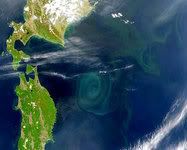2005 YU55 will be 200,000 miles away on November 8
Scientists have predicted it would cause a giant earthquake or a huge tsunami if it hit Earth
The last time a rock of a comparable size passed so close was in 1976, but it was missed by NASA
An asteroid the size of an aircraft carrier is set to pass closer to Earth than the moon – the nearest anything this big has come to our planet in 35 years.
The space rock has been classed as a ‘potentially hazardous object’ because it will shave our planet .8 lunar distances away on Tuesday, November 8.

Experts have calculated that if something of that size were to hit Earth it would cause a 4,000 megaton blast, a magnitude 7.0 earthquake, and if it hit water a 70-foot high tsunami would spread within 60 miles of the crash site.
The last time a rock this big passed so close was in 1976, but it was missed by everybody, including NASA.
Near-Earth asteroid: 2005 YU55 will shave our planet .8 lunar distances away on Tuesday, November 8
NASA’s Near-Earth Object manager Don Yeomans said this week that they are to carefully study 2005 YU55, which will be 200,000 miles away, because it will give ‘clues as to what it was like when our solar system was forming.’
‘Without objects of this type, we probably wouldn’t be here,’ he added.
It will not be visible to the naked eye, but amateur astronomers could see it if they use a telescope at least 6in in diameter as it approaches from a sunward direction.
Encounters of objects this large, this close to our planet, will not happen again until 2028 when an asteroid will pass near Earth to within .6 lunar distances.
NASA will use its super-sensitive Goldstone radar antennas in California’s Mojave Desert, usually used to study quasars, as well as map planets and comets.
Scientists say they can reconstruct the shape of the asteroid with a resolution as fine as 13 feet using their instruments and plan to do similar studies at Arecibo Observatory in Puerto Rico.
2005 YU55 was ‘imaged’ in Puerto Rico on April 19 last year.
The data collected has allowed the Near-Earth Object Program Office at NASA’s Jet Propulsion Laboratory (JPL) to refine the space rock’s orbit, enabling scientists to rule out any possibility of an Earth impact for the next 100 years.
A NASA spokesman said: ‘We hope to obtain images that should reveal a wealth of detail about the asteroid’s surface features, shape, dimensions and other physical properties.’
Barbara Wilson, a scientist at NASA’s Jet Propulsion Laboratory added: ‘While near-Earth objects of this size have flown within a lunar distance in the past, we did not have the foreknowledge and technology to take advantage of the opportunity.
‘When it flies past, it should be a great opportunity for science instruments on the ground to get a good look.’





